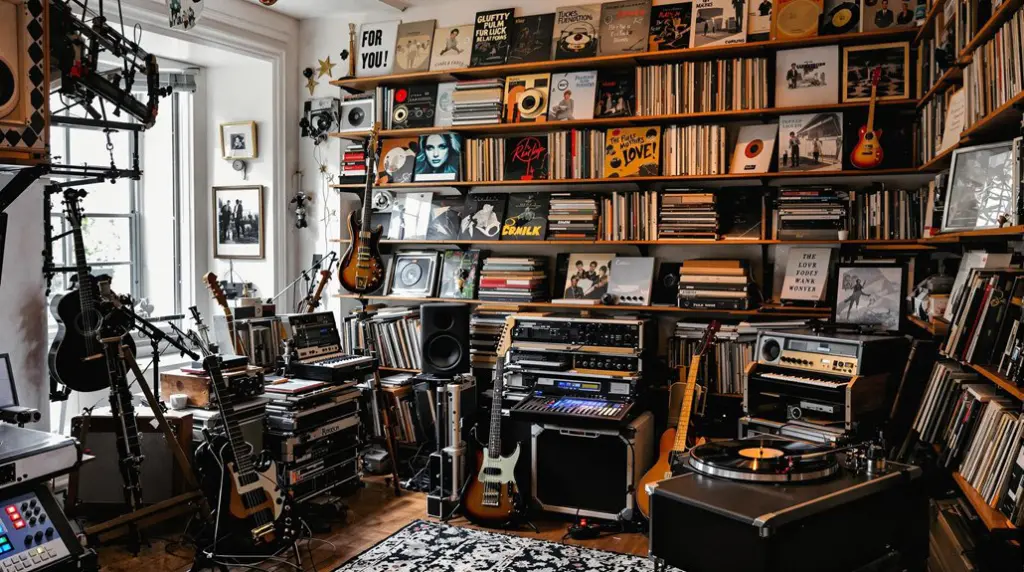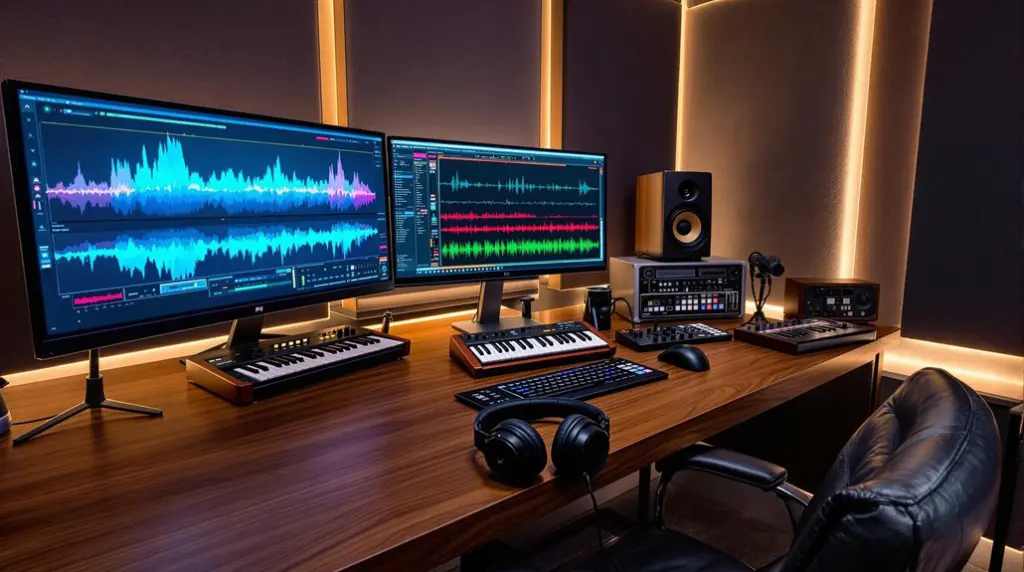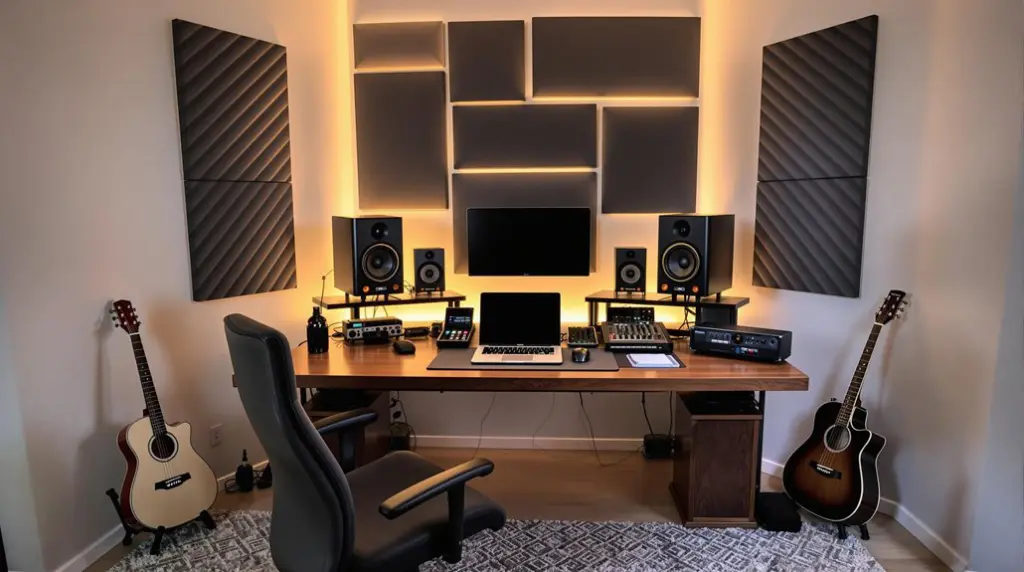To perfectly EQ your acoustic guitar, follow these five steps. First, understand basic EQ principles, focusing on frequency ranges. Second, identify problematic frequencies using a parametric EQ to tackle muddiness at 250 Hz and nasal tones at 800 Hz. Third, adjust frequency ranges; boost 150-300 Hz for warmth, cut 600-800 Hz for clarity, and enhance sparkle above 3.5 kHz. Fourth, blend with other instruments by managing overlapping frequencies and applying high-pass filters. Finally, maintain natural sound quality through subtle boosts and cuts while ensuring contextual evaluation. For a deeper exploration of effective techniques, further insights await.
Key Takeaways
- Apply a high-pass filter around 100 Hz to eliminate muddiness and maintain warmth in your acoustic guitar sound.
- Identify and cut problematic frequencies, focusing on 250 Hz for muddiness and 800 Hz to reduce nasal tones.
- Boost frequencies between 1,000-3,500 Hz for enhanced presence and articulation, especially in fingerpicking styles.
- Adjust midrange frequencies (800 Hz-2 kHz) to enhance clarity and prevent boxiness when blending with other instruments.
- Add sparkle by boosting 3,500-12,000 Hz while using a low-pass filter above 8 kHz to mitigate harshness.
Understand EQ Basics
Equalization (EQ) serves as a fundamental tool in audio production, enabling sound engineers and musicians to sculpt the tonal characteristics of acoustic guitars with precision.
The process of EQ involves adjusting the balance of frequency ranges—low (20-250 Hz), mid (250 Hz-4 kHz), and high (4 kHz-20 kHz)—which are essential for achieving a clear acoustic guitar sound. Employing a high-pass filter to cut frequencies below 70-100 Hz is necessary for eliminating muddiness, while strategically boosting around 3-5 kHz enhances brightness and articulation. Understanding key frequencies is important for mixing acoustic guitar tracks effectively, as overlapping frequencies can cause masking, leading to a lack of clarity.
Various EQ types, including parametric and shelving filters, offer nuanced control over these frequency ranges, facilitating ideal tonal shaping. Mastering subtractive EQ techniques can also help to achieve a more balanced mix by cutting unwanted frequencies.
Identify Problematic Frequencies
When mixing acoustic guitar tracks, identifying problematic frequencies is essential for achieving a balanced and clear sound. Employing a parametric EQ allows for precise analysis of the frequency spectrum.
Focus on ranges around 250 Hz to address muddiness and 800 Hz for nasal tones. Implementing a high pass filter to cut frequencies below 100 Hz can eliminate unwanted low-end rumble, while minor adjustments around 240 Hz can enhance clarity without compromising the warmth of a good acoustic guitar.
Additionally, boosting frequencies between 1-5 kHz reveals presence and articulation, ensuring the guitar stands out in the mix. Regularly monitor the 2-5 kHz range to enhance definition, avoiding harshness while maintaining clarity. Using surgical EQ cuts can further refine your adjustments by isolating specific problem frequencies without affecting surrounding tones.
Adjust Frequency Ranges
Identifying problematic frequencies lays the groundwork for effective equalization, but the next step involves adjusting specific frequency ranges to refine the acoustic guitar’s tone within a mix.
To enhance warmth and body, consider a slight boost in the 150-300 Hz range, while avoiding muddiness. Cutting frequencies around 600-800 Hz improves clarity, essential in dense mixes.
For presence and articulation, particularly in fingerpicking styles, a boost in the 1,000-3,500 Hz range is vital. Adding sparkle can be achieved by boosting frequencies between 3,500-12,000 Hz, starting around 3.5 kHz.
Additionally, utilizing a high-pass filter set between 70-100 Hz effectively reduces unwanted low-end rumble, ensuring your EQ Acoustic Guitar stands out prominently in the recording process. Understanding frequency ranges is essential for achieving a cohesive mix, particularly when balancing the acoustic guitar with other instruments.
Blend With Other Instruments
To achieve a cohesive mix, blending acoustic guitar with other instruments necessitates careful management of overlapping frequency ranges.
Particularly, focus on the critical 100Hz-300Hz and 2kHz-5kHz areas, where clashes often occur.
Consider the following EQ moves:
- Employ a high-pass filter around 80-100Hz to maintain a cleaner low-end balance.
- Adjust midrange frequencies (800Hz-2kHz) to enhance the acoustic guitar’s presence.
- Implement slight cuts in the 200-400Hz range to prevent boxiness.
- Boost 3.5kHz on the guitar while cutting similar frequencies on other instruments for clarity.
- Pay attention to the high end to guarantee the acoustic guitars blend seamlessly with other acoustic instruments.
These strategies will foster a more defined sonic space, enhancing the overall mix. Additionally, using subtractive EQ techniques can further refine your acoustic guitar’s sound by cutting unwanted frequencies.
Maintain Natural Sound Quality
Achieving a well-blended mix with acoustic guitar sets the stage for maintaining its natural sound quality. To reduce muddiness while preserving warmth, apply a high-pass filter around 100 Hz.
Careful adjustments within 2-3 dB for EQ boosts can enhance clarity without compromising the instrument’s inherent tone. Emphasizing midrange frequencies (800 Hz – 2 kHz) is vital for achieving body and presence; however, cuts in this range should be approached cautiously to avoid a thin sound.
A low-pass filter above 8 kHz helps mitigate harshness while retaining important high-frequency details. Regularly evaluate the acoustic guitar’s sound in context with other instruments to guarantee it maintains its natural character and presence without dominating the mix. Additionally, utilizing spectrum analyzers can aid in identifying frequency overlaps that may affect clarity.
Frequently Asked Questions
How Do I Get a Good Acoustic Guitar Tone?
Achieving a good acoustic guitar tone involves selecting appropriate guitar pickup types, choosing quality acoustic strings, considering room acoustics impact, refining playing techniques, employing effective mic placement tips, and understanding tonewood effects for ideal resonance.
How Should I EQ My Guitar?
To effectively EQ your guitar, utilize EQ techniques that target specific frequency ranges, enhancing acoustic nuances. Employ tone shaping strategies and sound engineering principles, incorporating mixing tips for clarity, warmth, and presence in your overall sound.
How to EQ an Acoustic Guitar Cheat Sheet?
An acoustic guitar EQ settings overview involves understanding acoustic guitar frequencies, utilizing EQ plugins for tone shaping, and adjusting live sound EQ. Proper miking techniques enhance clarity, allowing for precise balance across frequency ranges during mixing.
What Hz Is Best for Acoustic Guitar?
The best acoustic guitar frequencies include boosting 100-300 Hz for warmth, utilizing a high-pass filter around 70-100 Hz for clarity, and enhancing 3-5 kHz for articulation, while managing frequencies above 8 kHz to avoid clutter.
Conclusion
To summarize, achieving ideal equalization for an acoustic guitar requires a methodical approach encompassing understanding of EQ fundamentals, identification of problematic frequencies, precise adjustments across frequency ranges, effective blending with other instruments, and preservation of the instrument’s natural sound quality. Each step contributes to enhancing the overall sonic profile, ensuring clarity and balance within a mix. By systematically applying these techniques, one can greatly improve the acoustic guitar’s presence and effectiveness in various musical contexts.




